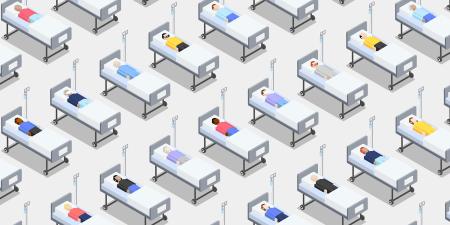Abstract
Patients often report experiencing boredom during inpatient psychiatry stays. Because patients’ vulnerabilities and conditions can be exacerbated when they feel bored, this article considers ethical dimensions of inpatient units’ designs that limit patients’ autonomy or access to activities or interactions with others. This commentary on a case also considers whether and how boredom should be considered an iatrogenic harm and influence discharge planning.
Case
NM is an adult hospitalized for depression and suicidal thoughts. She finds days in the hospital long and tedious. She attends all groups that are offered, sometimes as few as one per day on weekends. She watches TV, paces, and feels comfortable expressing her need for more stimulating programming if she is to heal. She broaches discharge planning with Dr Z, her psychiatrist, and states that she’d feel much better if she could be more active at home, which would help her mood.
Commentary
Boredom is both a universally understood experience and a nebulous concept. A theme in philosophical writings for centuries, boredom or ennui can be understood as an uncomfortable state devoid of meaning that is distinct from apathy or anhedonia.1,2 The interaction of certain intrinsic or transient vulnerabilities unique to an individual (sometimes described in the literature as trait boredom) and an environment that is either under- or overstimulating could result in profound boredom.1 As a result, some subsets of people might be prone to boredom regardless of their situation, and other experiences of boredom might be driven by a monotonous situation.3 An external locus of control has been associated with increased risk of boredom.4 In any case, a person who is bored is unable to effectively engage with their environment, as NM describes. Multidisciplinary research on the psychological phenomenology of boredom, as well as its implications (outside industry and education), is a relatively new area of study.5
This article considers the nature of boredom in hospitals, the possible iatrogenic harms and benefits of boredom, and how to weigh the risks of boredom against the benefits of discharge.
Psychiatry and Boredom
Much of the research and qualitative commentary on boredom among hospitalized psychiatry patients has been published in the nursing6,7 and occupational therapy5,8,9,10,11 literature. Boredom is commonly reported in hospitals, where patients may sense that “time stands still.”12 Many patients admitted to psychiatry are highly susceptible to boredom as a result of their illness, with depression, personality disorders, anxiety, and psychosis all found to increase risk of boredom.1,13 Interestingly, a lengthier or involuntary admission is not associated with increased boredom.13 Some speculate that the loss of autonomy on the unit contributes to loss of engagement or meaning that is associated with boredom.6,13 Several aspects of inpatient psychiatric wards clearly contribute to patients’ experience of boredom. Despite staff perceiving units as “busy,” given their own job duties and group programming offered to patients, as much as 90% (weekdays) to 96% (weekends) of patients’ time (as measured in one secure Australian forensic unit) comprises passive activities.11 Patients spend many unstructured hours without access to activities they can typically do at home, including chores, media consumption, or professional labors. Visiting hours with loved ones and time outdoors are restricted, if available at all. As our patient NM notes, programming is often further reduced on the weekend.
Boredom as Harm
To assess whether boredom should be considered an iatrogenic harm in this case and more generally on inpatient psychiatric units, a definition of iatrogenic harm must be specified. Broadly, iatrogenic harm can be conceptualized as a medical intervention that reduces a person’s health or well-being or hinders their recovery. This harm can be either psychological (eg, by causing distress) or physical (eg, by causing pain or impairing functioning). Moreover, not only the presence of harm but also the severity of the adverse effect is relevant to assessing whether boredom is harmful, since medical decisions involve weighing potential risks and benefits of the proposed intervention against the risks and benefits of inaction or an alternative intervention.14
The impact of boredom on NM’s well-being can be assessed by examining the potential adverse outcomes associated with boredom. Psychiatric inpatient environments reduce patient autonomy, as patients are detached from their normal routine, isolated from loved ones, and separated from personal items and electronics.6,7 Furthermore, the limited opportunities for stimulating structural interventions and programming are commonly cited as restrictive10,15 and repetitive.10 Any combination of these factors can exacerbate the distress of patients like NM and induce their mental disengagement from the treatment environment.13 NM approached Dr Z after exhausting all available programming and resources. Her boredom prompts her to request discharge rather than continuing to engage with inpatient treatment.
Patient boredom is also correlated with, and can intensify, many core symptoms of mental health disorders and dysfunctional behaviors, as well as symptoms of depression such as anhedonia, amotivation, and impaired attention.8,13 Suicidal thoughts and depression—the symptoms that led to NM’s hospitalization—can be amplified by her feelings of boredom on the unit, as the abundance of unstructured time can lead to ruminative thoughts, a sense of hopelessness, and worsened depressive symptoms.7 In addition, increased boredom is associated with substance use9 and other risky or impulsive behaviors like violence and criminality.5 Relatedly, patient boredom is a major risk factor for absconding from inpatient forensic facilities.10,16 When experienced by patients like NM, boredom might not only magnify symptoms but also, in extreme cases, manifest as dysregulated behaviors, such as aggression, self-harm, or elopement from the unit.
An abundance of unstructured time can lead to ruminative thoughts, a sense of hopelessness, and worsened depressive symptoms.
NM’s experience of boredom might also be critically influenced by the capacities of the unit staff.6,17,18 Many psychiatric wards experience staffing shortages, thereby reducing individualized patient-staff interactions, support resources, and opportunities for socialization and engagement. A common reason that psychiatric inpatients report boredom is their experience of limited interaction and engagement,19 which can be amplified for a patient who is physically isolated to comply with infection-control protocols. In addition, patient boredom might be trivialized or dismissed by mental health staff.6 NM’s feeling that her concerns about boredom are not heard or addressed by staff could amplify her psychological discomfort and its associated distress. Strained staff-patient relationships are antitherapeutic and can impair collaboration on treatment planning, leading to distrust and lack of rapport that can potentially jeopardize clinical treatment and outcomes.
Benefits of Boredom?
On the other hand, some argue that boredom provides an opportunity for meaningful personal growth.20 Extrapolating to hospitalized psychiatric populations, one could speculate that boredom might drive hospitalized patients to try new activities and undertake new experiences. If we conceive a possible benefit of boredom as an opportunity to enjoy quiet, NM’s unregulated time on the unit could allow opportunities for her to engage in self-care activities, reflection, and psychotherapy. However, NM found the days in the hospital long and tedious and explicitly requested more stimulating programming to promote effective recovery. NM therefore might need more structured support and activities to aid her treatment and recovery.
Boredom might also lead to more socialization opportunities.20 Patients experiencing boredom might seek interpersonal connections on the unit, leaving their rooms to participate in activities and engage with other patients and staff. However, as mentioned above, the limited opportunities for structured socialization in NM’s inpatient environment might not provide a conducive environment for socialization. NM already attends all offered groups, and she may struggle to initiate additional unstructured socialization.
Boredom might additionally stimulate curiosity and creativity. Although it has been argued that situations and feelings of boredom can spark opportunities for creativity and promote innovative goal setting,5,20 NM is in an environment that restricts her ability to pursue creative ideas. Psychiatric inpatients have often reported that they felt limited by their resources, spaces, and choices.11 Additionally, in more restrictive psychiatric environments, including forensic10 and intensive care17,18 settings, there are even more limitations and constraints on what is permitted to be in patients’ possession. These environmentally dependent factors pose significant barriers to cultivating creativity in the hospital.
Mitigating Harms of Boredom
To mitigate prospective harms of boredom, interventions could address the internal or external risk factors for boredom discussed above. NM focuses on the latter, in particular the paucity of activities available to her over the weekend on the unit compared to her more stimulating home environment. If she were not already attending group activities, her treatment team could encourage and support her participation. Interventions suggested to reduce boredom on inpatient wards include popular, novel activities that include opportunities for creative productivity,3,11 recreational activities such as exercise,21 behavioral activation therapy,18 and collaborative treatment planning with meaningful efforts directed at patients’ recovery and future.5,10,20 These interventions require interprofessional collaboration that can be resource intensive and time-consuming to implement, and care should be taken to ensure such programs are patient centered and foster autonomy.5 For NM, revising unit program offerings before the weekend is not feasible. Even with abundant activities, she might experience boredom due to other environmental factors outside of Dr Z’s control or due to inherent risk factors limiting her ability to tolerate distress or make meaning in this situation.
Therefore, Dr Z might consider interventions to target NM’s intrinsic vulnerabilities that make her prone to boredom. On psychiatric units, the core intervention is treating the underlying psychiatric illness that prompted admission, illness that often inherently increases risk of boredom.13 For example, as symptoms of depression—such as amotivation and impaired attention—resolve, patients might be better able to engage in meaningful endeavors. They might also be able to utilize more effective coping skills, such as mindfulness, which has been proposed as a useful intervention to combat boredom1,5,13; mindfulness is a skill that can be taught and cultivated on inpatient units. Treatment teams can discuss boredom with patients and develop a coping plan for it, much as patients cope with other sources of distress. To make this plan, a clinician might help a patient reflect on their previous experiences of boredom, anticipate triggers for future episodes, and identify strategies to cope, such as learning how to self-soothe, tolerate distress, or engage in activities aligned with their values. For example, NM could write a schedule that includes activities and goals for the weekend. Such strategies are core elements of behavioral therapies commonly introduced on inpatient psychiatry units. Follow-up could generate fruitful discussions about patients’ progress and goals, highlighting what brings meaning to their lives. Such conversations between clinician and patient about a coping plan might also support formal safety planning, an element of discharge planning that has become standard of care.
Ultimately, potential harms and benefits of boredom for NM over the weekend would need to be weighed carefully against the risks and benefits of discharge now, as requested. Her admission was prompted by suicidal thoughts, so a careful suicide risk assessment will be essential. If concern for suicide remains high, keeping NM alive through hospitalization certainly trumps harms related to boredom on the unit. If, however, suicidal thoughts have resolved, her planned discharge date is close at hand, outpatient support is high, and proximity to psychiatric follow-up is close, Dr Z might consider potential discharge to be low risk relative to the harms of boredom on the unit and thus support discharge.
Conclusion
Boredom is a harm that might result from psychiatric hospitalization and affects many—though certainly not all—patients. Boredom is justified in situations in which the likely harms of the alternatives to hospitalization are more severe than the harm caused by boredom. On the other hand, boredom is not a justifiable iatrogenic harm if the reduction in psychological well-being induced by boredom outweighs the benefit of hospitalization. In this case, Dr Z should consider how boredom is harming NM and compare the risks of continued boredom vs the risks of discharge. Ample data support the conclusion that harm is caused by boredom in inpatient psychiatry environments, and psychiatric hospitals have an obligation to take reasonable measures to reduce boredom. Mental health clinicians should consider boredom as a risk of hospitalization and take it into account when making treatment decisions.
References
- Martin M, Sadlo G, Stew G. The phenomenon of boredom. Qual Res Psychol. 2006;3(3):193-211.
- Goldberg YK, Eastwood JD, LaGuardia J, Danckert J. Boredom: an emotional experience distinct from apathy, anhedonia, or depression. J Soc Clin Psychol. 2011;30(6):647-666.
-
Steele R, Henderson P, Lennon F, Swinden D. Boredom among psychiatric in-patients: does it matter? Adv Psychiatr Treat. 2013;19(4):259-267.
- Hunter JP, Csikszentmihalyi M. The positive psychology of interested adolescents. J Youth Adolesc. 2003;32(1):27-35.
- Marshall CA, McIntosh E, Sohrabi A, Amir A. Boredom in inpatient mental healthcare settings: a scoping review. Br J Occup Ther. 2020;83(1):41-51.
- Shattell MM. Boredom in acute psychiatric care. Issues Ment Health Nurs. 2007;28(6):661-662.
- Binnema D. Interrelations of psychiatric patient experiences of boredom and mental health. Issues Ment Health Nurs. 2004;25(8):833-842.
- Newell S. Boredom, mental health inpatients and occupational therapy. Ment Health Occup Ther. 2009;14(1):25-27.
- Corvinelli A. Alleviating boredom in adult males recovering from substance use disorder. Occup Ther Ment Health. 2005;21(2):1-11.
- Bowser A, Link W, Dickson M, Collier L, Donovan-Hall MK. A qualitative study exploring the causes of boredom for men with a psychosis in a forensic setting. Occup Ther Ment Health. 2018;34(1):32-48.
- Farnworth L, Nikitin L, Fossey E. Being in a secure forensic psychiatric unit: every day is the same, killing time or making the most of it. Br J Occup Ther. 2004;67(10):430-438.
- Radley A, Taylor D. Images of recovery: a photo-elicitation study on the hospital ward. Qual Health Res. 2003;13(1):77-99.
- Newell SE, Harries P, Ayers S. Boredom proneness in a psychiatric inpatient population. Int J Soc Psychiatry. 2012;58(5):488-495.
- Unruh CF. A hybrid account of harm. Australas J Philos. 2023;101(4):890-903.
- Foye U, Li Y, Birken M, Parle K, Simpson A. Activities on acute mental health inpatient wards: a narrative synthesis of the service users’ perspective. J Psychiatr Ment Health Nurs. 2020;27(4):482-493.
-
Wilkie T, Penney SR, Fernane S, Simpson AI. Characteristics and motivations of absconders from forensic mental health services: a case-control study. BMC Psychiatry. 2014;14:91.
- Taube-Schiff M, Carroll A, Flogen S. The development of a modification of behavioural activation as a solution to reduce patient boredom in a PICU: overcoming patient and staff challenges. J Psychiatr Intensive Care. 2016;12(2):63-68.
- Taube-Schiff M, Yufe S, McLeod J, et al. Creating change: implementation of an inpatient behavioural activation programme on a psychiatric intensive care unit. J Psychiatr Intensive Care. 2017;13(1):17-25.
- Shattell MM, Andes M, Thomas SP. How patients and nurses experience the acute care psychiatric environment. Nurs Inq. 2008;15(3):242-250.
- Elpidorou A. The good of boredom. Philos Psychol. 2018;31(3):323-351.
- Janner M, Delaney KR. Safety issues on British mental health wards. J Am Psychiatr Nurses Assoc. 2012;18(2):104-111.



